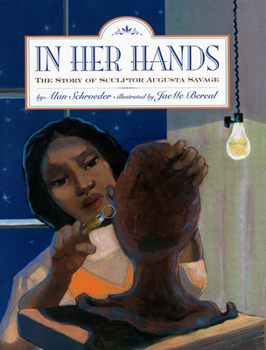In Her Hands: The Story of Sculptor Augusta Savage
Select Format
Select Condition 
Book Overview
A recreation of events from the childhood and early career of Augusta Savage, a pioneering female sculptor and major figure of the Harlem Renaissance. As a young girl in Florida in the 1890s, Augusta enjoyed nothing more than playing with clay. She would happily sculpt it into little figures: cows, chickens, ducks. Augusta's mother didn't mind but her father, a stern preacher, felt the girl was wasting time on idle nonsense. With...
Format:Hardcover
Language:English
ISBN:1600603327
ISBN13:9781600603327
Release Date:October 2009
Publisher:Lee & Low Books
Length:48 Pages
Weight:1.04 lbs.
Dimensions:0.5" x 8.5" x 11.0"
Age Range:7 to 10 years
Grade Range:Grades 2 to 5
Customer Reviews
3 ratings
Biography of an almost forgotten woman artist
Published by Thriftbooks.com User , 14 years ago
Augusta Savage, a poor African-American girl living in Florida in the 1890s, loved to make figures from the clay she dug up around her house. Her father, a preacher, discouraged this hobby, believing the figures to be profane and sinful. At the age of 27, she won a sculpture contest at the county fair, and used the prize money to move to New York, where she gained entry to the Cooper Union School of Art. Rich paintings by JaiMe Bereal accompany this absorbing biography. The afterword gives a succinct summary of her career after college: she became a noted sculptor and art teacher during the 1930s. I have included this book in my online Gender Equality Bookstore.
Will appeal to an audience ages 7-13 and should be an inspiration to young artists today
Published by Thriftbooks.com User , 15 years ago
"In Her Hands: The Story of Sculptor Augusta Savage" is a compelling children's biography of Harlem Renaissance sculptor Augusta Savage (1892-1962), gracefully unfolded by Alan Schroder and richly imaged in realistic paintings by JaeMe Bereal. Described as an enigmatic figure in American art, Augusta began her career as a young girl creating clay animals in Florida, despite her preacher father's stern disapproval. Augusta faced and persevered through many difficult obstacles but she became proficient at her chosen field of art through continued scholarship-sponsored education in New York City. Suffering from illness and depression in her later life, Augusta's reputation flagged, after some very famous works were achieved, including "The Harp" and "Gamin," a bronze bust of a jaunty boy made in 1929. Because some of her work has been lost or destroyed, Augusta Savage is not as well-remembered today as she deserves to be. In the 1930's, however, "she was a guiding light of the Harlem Renaissance." "In Her Hands" will appeal to an audience ages 7-13 and should be an inspiration to young artists today.
Rutgers University Project on Economics and Children
Published by Thriftbooks.com User , 15 years ago
With his fourteen children to rear and his strict religious views, Augusta Savage's father had no patience or tolerance for his daughter's fondness of sculpting small figures from the open clay pit behind their house. Fortunately his strong discouragement did not squelch her passion, and as she grew into a young adult, Augusta had several opportunities to develop and showcase her unique sculpting talent. One of these opportunities led Augusta from her Florida birthplace to New York City, where she impressed the director of the Cooper Union Art School enough to gain admission to the tuition-free school. She flourished professionally and ultimately became an influential sculptor and teacher in the Harlem Renaissance of the 1920s and 1930s. Because much of Augusta Savage's art work was either destroyed or kept in unknown locations, the visible reminders of her expressive sculpting style remain limited and out of the public eye. Yet she had a strong impact on the art world, not only with the various busts, carvings, and sculptures that she created, but also through her mentoring and teaching of younger students in her studio. Alan Schroeder and JaeMe Bereal do young readers a tremendous service by bringing this talented artist's contributions to light. Woven throughout the text is the theme of poverty and how financial constraints influenced the path that she took and the materials with which she chose to work.






